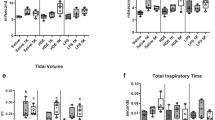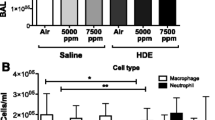Abstract
Exposure in swine confinement buildings induces an intense airway inflammation. Twenty-two volunteers, of whom eleven wore a half-mask, were exposed for 3 hr in a swine barn. Blood samples were drawn before and after exposure. The ratio C3b/totalC3 in plasma decreased from 6.8 to 5.0% (p = 0.02) without mask and from 6.6 to 5.9% (p = 0.01) with mask (p = 0.67 between groups). The ratio Bb/totalB decreased from 14.5 to 13.5% (p < 0.01) without and 14.6–13.3% (p = 0.09) with mask (p = 0.25 between groups). Epithelial cells (A549) incubated up to 24 hr with 0.1 mg/mL dust suspensions were analysed for C3, IL-6 and IL-8 secretion. Cumulative C3 synthesis of dust stimulated cell cultures was 43,000 pg/mL compared to 25,000 pg/mL in unstimulated cells. Cumulative dust-induced IL-6 and IL-8 secretion was 200 and 3000 pg/mL, respectively and below detection in unstimulated cells.The activation of complement in vivo and induced C3 synthesis by epithelial cells suggests a role of complement in the airway reaction to organic dust exposure.
Similar content being viewed by others
References
Sahu, A., J. O. Sunyer, et al. 1998. Structure, functions, and evolution of the third complement component and viral molecular mimicry. Immunol. Res. 17(1–2):109–121.
Donham, K., P. Haglind, et al. 1989. Environmental and health studies of farm workers in Swedish swine confinement buildings. Br. J. Ind. Med. 46(1):31–37.
Donham, K. J. 1990. Health effects from work in swine confinement buildings. Am. J. Ind. Med. 17(1):17–25.
Larsson, K., A. Eklund, et al. 1992. Alterations in bronchoalveolar lavage fluid but not in lung function and bronchial responsiveness in swine confinement workers. Chest 101(3):767–774.
Larsson, B. M., L. Palmberg, et al. 1997. Effect of exposure to swine dust on levels of IL-8 in airway lavage fluid. Thorax 52(7):638–642.
Wang, Z., K. Larsson, et al. 1997. Inhalation of swine dust induces cytokine release in the upper and lower airways. Eur. Respir. J. 10(2):381–387.
Wang, Z., P. Malmberg, et al. 1996. Time course of interleukin-6 and tumor necrosis factoralpha increase in serum following inhalation of swine dust. Am. J. Respir. Crit Care Med. 153(1):147–152.
O'Sullivan, S., S. E. Dahlen, et al. 1998. Exposure of healthy volunteers to swine house dust increases formation of leukotrienes, prostaglandin D2, and bronchial responsiveness to methacholine. Thorax 53(12):1041–1046.
Sundblad, B. M., B. M. Larsson, et al. 2002. Exhaled nitric oxide and bronchial responsiveness in healthy subjects exposed to organic dust. Eur. Respir. J. 20(2):426–431.
Sundblad, B. M., L. Palmberg, et al. 2002. Bronchial responsiveness to eucapnic hyperventilation and methacholine following exposure to organic dust. Chest 122(1):363–368.
Wang, Z., P. Malmberg, et al. 1999. Swine dust induces cytokine secretion from human epithelial cells and alveolar macrophages. Clin Exp. Immunol. 115(1):6–12.
Palmberg, L., B. M. Larsson, et al. 1998. Induction of IL-8 production in human alveolar macrophages and human bronchial epithelial cells in vitro by swine dust. Thorax 53(4):260–264.
Pedersen, S., M. Nonnenmann, et al. 2000. Dust in pig buildings. Int. Symp. on Neuro-Fuzzy Syst., Proc. 6(4):261–274.
Iversen, M., S. Kirychuk, et al. 2000. Human health effects of dust exposure in animal confinement buildings. Int. Symp. Neuro-Fuzzy Syst. Proc. 6(4):283–288.
Reid, K. B. M. 1998. Classical pathway of activation. The complement system. H. G. M. Heildelberg, Springer-Verlag: pp. 68–92.
Acevedo, F. 1999. Simple quantification of complement factors C3 and C3b using separation by isotachophoresis. Electrophoresis 20(3):469–472.
Acevedo, F. 1989. Isotachophoresis of proteins. J. Chromatogr., A 470(2):407–414.
Acevedo, F. 1991. Use of discrete spacers for the separation of proteins by gel isotachophoresis. J. Chromatogr. A 545:391–396.
Andrews, A. T. 1986. Electrophoresis—theory, techniques, and Biochemical and Clinical applications. Oxford, Oxford Science.
Ek, A., K. Larsson, et al. 1999. Fluticasone and budesonide inhibit cytokine release in human lung epithelial cells and alveolar macrophages. Allergy 54(7):691–699.
Strunk, R. C., D. M. Eidlen, et al. 1988. Pulmonary alveolar type II epithelial cells synthesize and secrete proteins of the classical and alternative complement pathways. J. Clin. Invest. 81(5):1419–1426.
Zhao, Y. X., A. Andoh, et al. 2000. Secretion of complement components of the alternative pathway (C3 and factor B) by the human alveolar type II epithelial cell line A549. Int. J. Mol. Med. 5(4):415–419.
Pasch, M. C., N. H. Van Den Bosch, et al. 2000. Synthesis of complement components C3 and factor B in human keratinocytes is differentially regulated by cytokines. J. Invest. Dermatol. 114(1):78–82.
Kirkhorn, S. R., and V. F. Garry. 2000. Agricultural lung diseases. Environ. Health Perspect. 108(Suppl. 4):705–712.
Wang, Z., A. Manninen, et al. 1998. Inhalation of swine-house dust increases the concentrations of interleukin-1 beta (IL-1 beta) and interleukin-1 receptor antagonist (IL-lra) in peripheral blood. Respir. Med. 92(8):1022–1027.
Kaca, W., E. Literacka, et al. (2000). Complement activation by Proteus mirabilis negatively charged lipopolysaccharides. J. Endotoxin. Res. 6(3):223–234.
Palmberg, L., B. M. Larsson, et al. (2004). Partial protection by respirators on airways responses following exposure in a swine house. Am. J. Ind. Med. 46(4):363–370.
Michel, O., J. Duchateau, et al. 1989. Effect of inhaled endotoxin on bronchial reactivity in asthmatic and normal subjects. J. Appl. Physiol. 66(3):1059–1064.
Larsson, B. M., K. Larsson, et al. 2002. Airways inflammation after exposure in a swine confinement building during cleaning procedure. Am. J. Ind. Med. 41(4):250–258.
Zhiping, W., P. Malmberg, et al. 1996. Exposure to bacteria in swine-house dust and acute inflammatory reactions in humans. Am. J. Respir. Crit. Care Med. 154(5):1261–1266.
Larsson, B. M., K. Larsson, et al. 1999. Gram positive bacteria induce IL-6 and IL-8 production in human alveolar macrophages and epithelial cells. Inflammation 23(3):217–230.
Author information
Authors and Affiliations
Rights and permissions
About this article
Cite this article
Acevedo, F., Palmberg, L. & Larsson, K. Exposure to Organic Dust Causes Activation of Human Plasma Complement Factors C3 and B and the Synthesis of Factor C3 by Lung Epithelial Cells In Vitro. Inflammation 29, 39–45 (2005). https://doi.org/10.1007/s10753-006-8968-0
Issue Date:
DOI: https://doi.org/10.1007/s10753-006-8968-0




